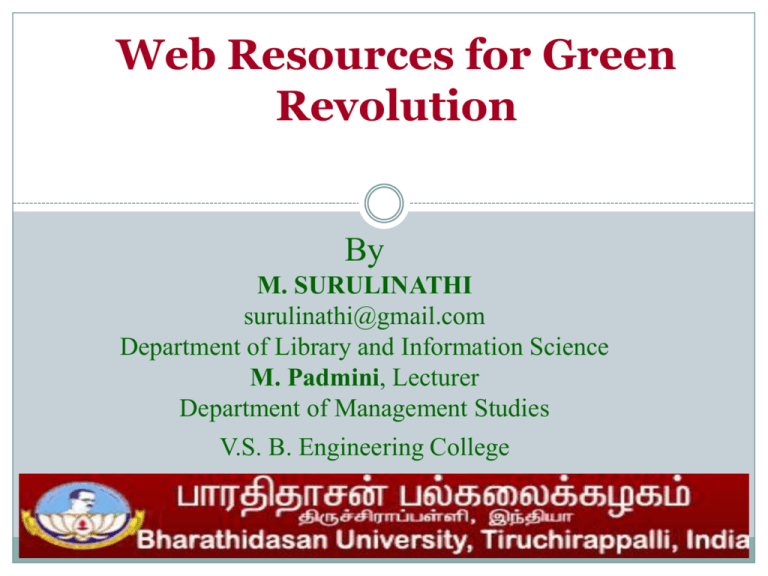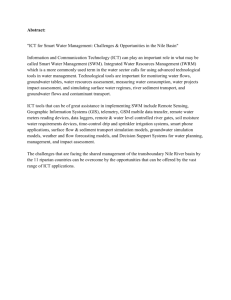Green Revolution
advertisement

Web Resources for Green Revolution By M. SURULINATHI surulinathi@gmail.com Department of Library and Information Science M. Padmini, Lecturer Department of Management Studies V.S. B. Engineering College Introduction Web The popularity of the World Wide Web and the incredible rapid growth of the web technology could not be imagined a decade ago. Web is a globally hyper linked electronic environment on which a lot of latest information is available in almost all subject areas. Rapid increase number of Internet access points all over the world leads to many research on new technologies for education and working. The creation and application of a web resources will support learning and teaching process. Web Resources ETD Video Sharing Websites E-Books E-Journals Multimedia@Teacher Tube Distribution of videos in Teachertube S. No. Key word/Terminology No of Videos 1 Green Buildings & Smart homes 7 2 Green Computing 19 3 Green ICT 10 4 Green Engineering 56 5 Green Educational Technologies 23 6 1 7 Green Manufacturing & Energy efficiency Sustainable development 29 8 Green Management and Marketing 6 MULTIMEDIA@YOUTUBE Distribution of video collection in youtube S. No. Key word/Terminology No of Videos 1 Green Buildings & Smart homes 891 2 Green Computing 2080 3 Green ICT 958 4 Green Engineering 5790 5 Green Educational Technologies 1430 6 Green Manufacturing & Energy efficiency 425 7 Sustainable development 9160 8 Green Management and Marketing 841 MULTIMEDIA@GOOGLE VIDEO Distribution collection in Google Video S. No. Key word/Terminology No of Videos 1 Green Buildings & Smart homes 1,280 2 Green Computing 3,040 3 Green ICT 1,690 4 Green Engineering 5 Green Educational Technologies 6 Green Manufacturing & Energy efficiency 7 Sustainable development 8 Green Management and Marketing 10,300 1,960 503 14,400 1,810 DOAJ Distribution Journal articles in DOAJ S. No. Key word/Terminology Publication s 1 Green Buildings & Smart homes - 2 Green Computing 9 3 Green ICT - 4 Green Engineering 2 5 Green Educational Technologies 1 6 Green Manufacturing & Energy efficiency - 7 Sustainable development 1696 8 Green Management and Marketing 1 Networked Digital Library of Theses and Dissertations Distribution of ETD in NDLTD S. No. Key word/Terminology E-Theses 1 Green Buildings & Smart homes 2 Green Computing 3 Green ICT 4 Green Engineering 54,326 5 Green Educational Technologies 13,398 6 Green Manufacturing & Energy efficiency 10,661 7 Sustainable development 39,249 8 Green Management and Marketing 17,123 3,534 21,936 2,846 BIBLIOGRAPHIC DATABASES Biographic databases are used to store collections of bibliographic records. Scopus and Web of Science databases contained fields to store information about a limited range of printed works, books reviews, articles, Letters, meeting abstract, Conference publications manuscripts etc. It also helps to know the Citations, H-index, Impact Factor for particular Journal and so on. Scopus Database Web of Science Distribution Publications in databases S. No. Key word/Terminology 1 Green Buildings & Smart homes 2 Green Computing 3 Green ICT 4 Green Engineering 5 Scopus Web of Science 1999-2011 594 3 1806 2462 172 52 11258 3259 Green Educational Technologies 105 18 6 Green Manufacturing & Energy efficiency 133 35 7 Sustainable development 68572 18206 8 Green Management and Marketing 1599 6966 Springerlink Sciencedirect Distribution of Resources S. No. Key word/Terminology 1 Green Buildings & Smart homes 2 Springer Elsevier 1,805 2808 Green Computing 36,791 63012 3 Green ICT 14,391 4563 4 Green Engineering 1,06,824 219200 5 Green Educational Technologies 12,513 17080 6 Green Manufacturing & Energy efficiency 3,752 14281 7 Sustainable development 70,377 121999 8 Green Management and Marketing 1,08,563 26925 Conclusion Digital Libraries and Multimedia brings together in one place important contributions and up-to-date research results in this fast moving area. Libraries need to balance provisions for greater access to text based information systems as opposed to limited-scale, multimedia products. Multimedia integrated library systems will become a necessity rather than a luxury. References Qiu Junping et al. “The application of Multimedia in Academic Library”, International Conference on Multimedia and Information Technology, pp.703-706, 2008. [2] R. Balasubramani, N. Amsaveni, M. Surulinathi, and C. Ranganathan,Web Resouces for Physical Education and Sports Sciences, National Conference on emerging trends in Physical Education and Sports Sciences, March 12, PP. 157-161, 2011. [3] http://videolectures.net/ [4] http://freevideolectures.com/mav.html [5] http://www.uwtv.org/index.aspx [6] http://web.sls.csail.mit.edu/lectures/ [7] http://videolectures.net/ [8] http://www.youtube.com [9] http://www.teachertube.com [1]



